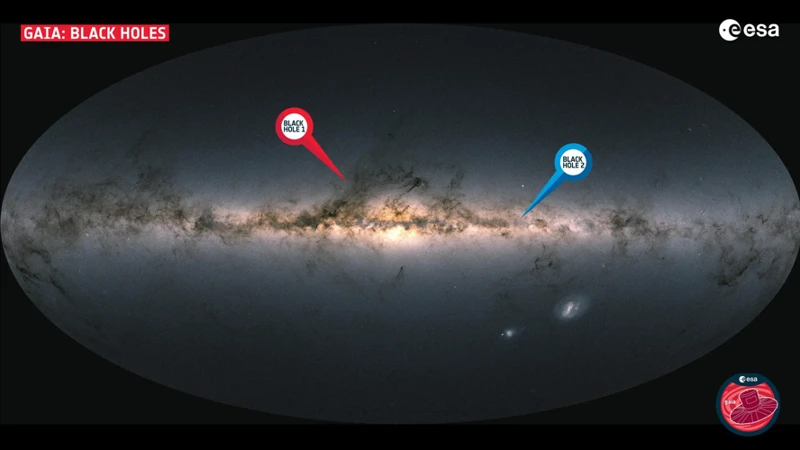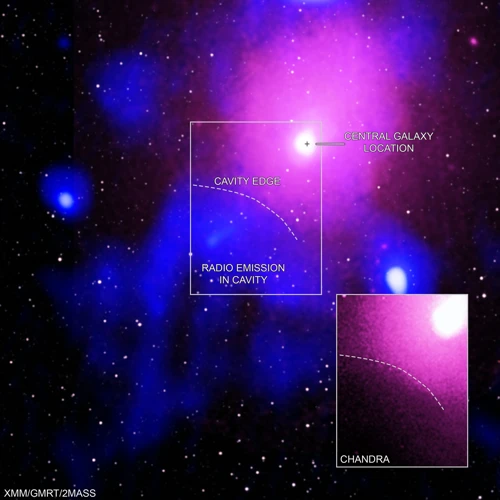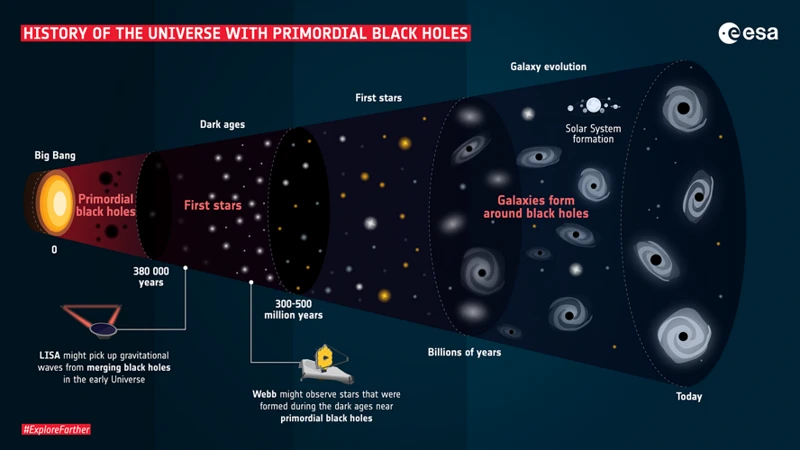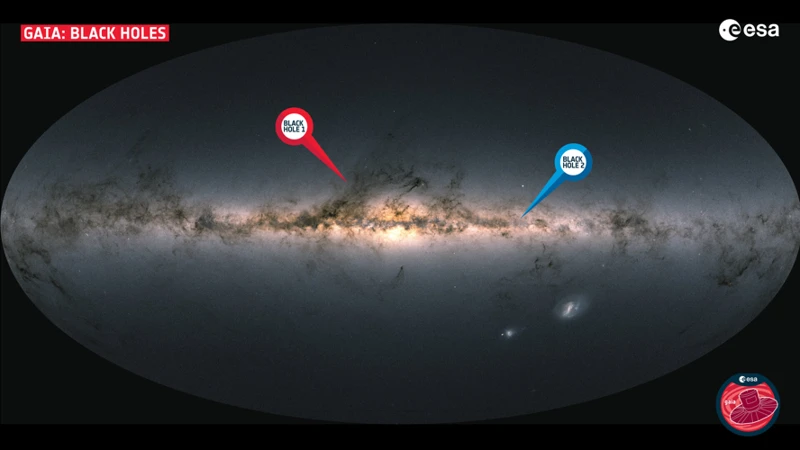Black holes have long been a source of fascination and mystery for astronomers and the general public alike. These enigmatic cosmic entities are known for their immense gravitational pull, which is so strong that nothing, not even light, can escape them. In this article, we will explore the different types of black holes that exist in the universe. From stellar black holes formed from the remnants of massive stars, to supermassive black holes lurking at the centers of galaxies, and even the mysterious primordial black holes that may have formed shortly after the Big Bang. Join us on this journey as we unravel the secrets of these celestial phenomena and delve into their formation, properties, and detection methods.
Contents
- 1. Stellar Black Holes
- 2. Supermassive Black Holes
- 3. Intermediate Black Holes
- 4. Primordial Black Holes
- 5. Micro Black Holes
- Conclusion
-
Frequently Asked Questions
- 1. How are stellar black holes formed?
- 2. What is the size of a typical stellar black hole?
- 3. Do stellar black holes emit any light?
- 4. Can stellar black holes be detected?
- 5. Are stellar black holes common?
- 6. Can stellar black holes pose a threat to our solar system?
- 7. Can anything escape the gravitational pull of a stellar black hole?
- 8. Are stellar black holes stable or do they eventually disappear?
- 9. Are there any known instances of stellar black holes colliding?
- 10. Can stellar black holes eventually consume everything in the universe?
- References
-
Frequently Asked Questions
- Why are black holes called “black”?
- Can black holes move?
- How do black holes form?
- Are there different sizes of black holes?
- Can black holes die or disappear?
- Can black holes collide with each other?
- Are there any dangers of black holes for Earth?
- How are supermassive black holes different from other types?
- Can black holes be detected or observed?
- Do black holes violate the laws of physics?
- References
- Read More
1. Stellar Black Holes

Stellar black holes are formed through the gravitational collapse of massive stars. When a star with a mass at least three times that of the Sun reaches the end of its life, it undergoes a supernova explosion, expelling its outer layers into space. What remains is a dense core known as a neutron star. If the mass of the neutron star exceeds a critical threshold, gravity overwhelms the neutron degeneracy pressure, causing the core to collapse further and form a black hole. These black holes have a mass ranging from a few times that of the Sun to several tens of times larger. The size of a stellar black hole is directly related to its mass, with a smaller radius indicating a higher density. These black holes possess an event horizon, which is the point of no return, beyond which nothing can escape the gravitational pull. Stellar black holes can be found both in isolation or as part of binary systems where they orbit with a companion star. The interaction between the black hole and its companion can lead to the accretion of matter from the companion onto the black hole, creating a phenomenon called an accretion disk and emitting X-rays. This process can aid in the detection of stellar black holes in the universe.
1.1 Formation
Under the topic of formation, stellar black holes are formed through a process known as gravitational collapse. The journey begins with a massive star, typically having a mass of at least three times that of the Sun. Throughout its life, the star undergoes nuclear fusion, where hydrogen is converted into helium and releases a tremendous amount of energy. However, once the star depletes its fuel, it enters its final stage. At this point, the star’s core can no longer sustain the outward pressure generated by nuclear fusion, causing it to collapse under the influence of its gravity. The collapse triggers a supernova explosion, expelling the outer layers of the star into space while leaving behind the dense core, known as a neutron star. If the mass of the neutron star exceeds a specific threshold, typically about three times the mass of the Sun, gravity overwhelms the neutron degeneracy pressure, causing the core to collapse further. The immense gravitational forces compress the core to a point where its density becomes infinite, forming a singularity. Surrounding the singularity is the event horizon, marking the boundary beyond which nothing can escape the black hole’s gravitational pull. Thus, through the gravitational collapse of massive stars, stellar black holes are born, possessing an intense gravitational influence that captivates our imagination.
1.2 Properties
The properties of stellar black holes are fascinating and unique. One of the key properties is their incredible gravitational pull, which is so strong that not even light can escape it. This property makes them invisible to the naked eye, as they do not emit any visible light. However, they can be detected through their effects on surrounding matter and radiation. Stellar black holes have a mass ranging from a few times that of the Sun to several tens of times larger. The size of the black hole is directly related to its mass, with a smaller radius indicating a higher density. Another notable property of stellar black holes is their ability to distort spacetime. Their immense gravitational force creates a curvature in the fabric of space, causing nearby objects to be influenced by their gravitational field. Additionally, stellar black holes have an event horizon, beyond which nothing can escape. Anything that crosses the event horizon is said to be inside the black hole’s “point of no return.” This property is what makes them appear black, as no light or information can be retrieved from beyond this point. The properties of stellar black holes continue to captivate scientists as they delve deeper into understanding the mysteries of these cosmic entities.
1.3 Detection
Detection of stellar black holes can be challenging due to their nature of being invisible. However, astronomers have developed several methods to identify and indirectly observe these cosmic objects. One method is through studying the effects they have on their surroundings. When a stellar black hole is part of a binary system, it can accrete matter from its companion star. This process creates an accretion disk where the matter falls into the gravitational well of the black hole, emitting X-rays in the process. By detecting these X-ray emissions using satellites and ground-based telescopes, astronomers can infer the presence of a black hole. Another method involves studying the gravitational interactions between black holes and other celestial objects. Black holes can cause visible stars to exhibit irregular and periodic motion, known as a wobble or orbital variations. By carefully observing these variations, scientists can deduce the presence of a black hole in the system. Additionally, gravitational waves, ripples in the fabric of spacetime, can be used to detect black holes. When two black holes merge, they generate powerful gravitational waves that can be detected by sensitive instruments like the Laser Interferometer Gravitational-Wave Observatory (LIGO). This groundbreaking method allows scientists to directly detect and study black holes in a way that was previously impossible. Through a combination of these methods, astronomers continue to expand our understanding of stellar black holes and their place in the universe.
2. Supermassive Black Holes

Supermassive black holes are a fascinating class of black holes that exist at the centers of galaxies, including our own Milky Way. These black holes have masses ranging from millions to billions of times that of the Sun, making them significantly larger than their stellar counterparts. The formation of supermassive black holes is still a topic of ongoing research and debate among astronomers. There are several proposed mechanisms for their formation, including the rapid accretion of matter, the collision and merger of smaller black holes, or the direct collapse of massive gas clouds in the early universe. One prominent theory suggests that supermassive black holes grow over time through a process called “galactic cannibalism,” where they devour neighboring stars, gas, and even other black holes. Despite their immense size, supermassive black holes are not easily detected due to their positional alignment with the bright core of the galaxy. However, scientists have developed various methods to indirectly observe them, such as studying the movement of stars surrounding the black hole or measuring the powerful jets of energy and radiation emitted from the accretion disks. These observations provide valuable insights into the role of supermassive black holes in shaping the growth and evolution of galaxies throughout the universe.
2.1 Formation
Supermassive black holes, as their name suggests, are significantly larger and more massive than stellar black holes. The formation of these colossal entities remains a topic of ongoing research and speculation. One popular theory is the hierarchical merger model, where supermassive black holes are thought to form through the repeated merging of smaller black holes and the accretion of vast amounts of gas and dust over cosmic timescales. Another possibility is the direct collapse model, where massive gas clouds collapse under their own gravity, bypassing the formation of a star and directly forming a supermassive black hole. These gas clouds are exceptionally dense and can rapidly accumulate mass. While both these theories provide possible explanations for the formation of supermassive black holes, the exact mechanisms and conditions that lead to their formation are still not fully understood. As a result, further research and observations are required to gain a deeper understanding of the formation processes involved.
2.2 Properties
The properties of supermassive black holes differentiate them from other types of black holes. As the name suggests, these black holes have an extremely large mass, ranging from millions to billions of times the mass of our Sun. Their size is directly correlated with their mass, resulting in an enormous event horizon, which signifies the boundary beyond which nothing can escape their gravitational pull. Supermassive black holes are commonly found at the centers of galaxies, including our own Milky Way. They play a crucial role in the evolution and dynamics of galaxies, exerting gravitational influences on surrounding stars and gas. The immense gravitational forces generated by these black holes can cause stars and other celestial objects to orbit around them at high velocities. This gravitational influence is also responsible for the formation of accretion disks, which are swirling disks of gas and dust that surround the black hole. These disks emit powerful radiation, including X-rays and radio waves, making them observable from great distances. The properties of supermassive black holes continue to intrigue scientists, and their study provides valuable insights into the mysteries of galaxy formation and evolution.
2.3 Detection
Detection of supermassive black holes, which reside at the centers of galaxies, is a complex task due to their immense distances and the absence of direct visual evidence. However, astronomers employ various indirect methods to identify and study these cosmic giants. One common approach is to observe the movement of stars and gas in the vicinity of the black hole. The powerful gravitational pull of the black hole causes these objects to orbit around it, creating a distinctive signature in the form of accelerated velocity. By analyzing the orbital patterns and the Doppler shifts in the emitted light, scientists can infer the presence of a supermassive black hole. Another method involves observing the emission of intense radiation from the accretion disk surrounding the black hole. As matter falls into the disk, it becomes extremely hot and emits high-energy radiation, including X-rays, which can be detected using specialized telescopes. This X-ray emission is indicative of the presence of a black hole. Additionally, gravitational lensing provides another avenue for detection. If a black hole lies along the line of sight between Earth and a distant light source, it can bend and distort the light, creating a magnifying effect. This gravitational lensing phenomenon can be observed and analyzed to indirectly confirm the presence of a supermassive black hole. These detection methods, combined with meticulous data analysis and modeling, allow astronomers to piece together the existence and properties of supermassive black holes, expanding our understanding of the vast cosmic landscape.
3. Intermediate Black Holes

Intermediate black holes, as the name suggests, fall in between the stellar black holes and supermassive black holes in terms of mass. These black holes have masses ranging from hundreds to thousands of times that of the Sun. The formation of intermediate black holes is still a subject of ongoing research and is not yet fully understood. It is speculated that they may form through the gradual accretion of matter within dense star clusters or through the collisions and mergers of smaller black holes. The properties of intermediate black holes are also not well-known, as they are challenging to detect due to their relatively small size and lower levels of activity compared to supermassive black holes. However, recent studies have suggested that the presence of intermediate black holes in galactic nuclei may have a role in the evolution of galaxies. Further research and observation are needed to unravel the mysteries surrounding these intriguing cosmic objects.
3.1 Formation
The formation of intermediate black holes is still an area of active research and remains somewhat uncertain. One of the proposed mechanisms for the formation of intermediate black holes is through the merger of smaller black holes or the gradual accretion of matter over an extended period. In the process of stellar evolution, binary star systems can play a crucial role in the creation of intermediate black holes. When a binary system contains two stars that are massive enough, they may evolve separately until one of the stars undergoes a supernova, leaving behind a black hole. Over time, the two stars may gravitationally interact, eventually spiraling inward towards each other. Through a series of mass transfer episodes, the black hole can capture material from the companion star, growing in size and mass. Another proposed mechanism for the formation of intermediate black holes involves the direct collapse of massive clouds of gas and dust, without the intermediate stage of stellar evolution. This process is thought to occur in regions of high-density molecular clouds, where gravitational instabilities can lead to the direct formation of a black hole. While the exact formation mechanism of intermediate black holes is still under investigation, these intriguing objects occupy a mass range between stellar black holes and supermassive black holes, usually ranging from several hundred to tens of thousands of times the mass of the Sun.
3.2 Properties
The properties of intermediate black holes continue to be a subject of research and exploration. These black holes have a mass between that of stellar black holes and supermassive black holes, typically ranging from hundreds to thousands of times the mass of the Sun. Due to their intermediate size, they exhibit certain unique characteristics. Their event horizons are larger than those of stellar black holes, yet smaller than supermassive black holes. Intermediate black holes can still emit X-rays if they are actively accreting mass from a companion star, similar to stellar black holes. Additionally, they may exhibit variability in their X-ray emissions as the accretion rate fluctuates. The exact formation mechanisms of intermediate black holes are still uncertain, but they are believed to form from the collapse of massive stars or through the mergers of smaller black holes. The study of these mysterious objects is crucial in understanding the hierarchy and evolution of black holes in the universe.
4. Primordial Black Holes

Primordial black holes are a hypothetical type of black hole that is believed to have formed in the early universe. Unlike stellar black holes that are created from the collapse of massive stars, primordial black holes are thought to have originated from fluctuations in the density of matter during the Big Bang. These fluctuations could have caused regions of high density to collapse under their own gravity and form black holes. Primordial black holes can have a wide range of masses, from as small as a mountain to as large as many times the mass of the Sun. If they exist, they could potentially explain certain astronomical phenomena, such as the source of dark matter or the origin of gravitational waves. Detecting primordial black holes is challenging, as they do not have a companion star or an accretion disk like stellar black holes. However, scientists have proposed several methods for their detection, including gravitational microlensing, which involves observing the bending of light from background stars as it passes through the gravitational field of the black hole. Further research and observation are needed to confirm the existence of primordial black holes and unravel the mysteries they may hold.
4.1 Formation
Primordial black holes, as the name suggests, are believed to have formed in the early stages of the universe. The exact mechanism of their formation is still a subject of debate among scientists. One proposed theory is that they emerged from the intense density fluctuations that occurred during the inflationary period shortly after the Big Bang. These density fluctuations could have led to the formation of regions of very high mass, which then underwent gravitational collapse to give rise to primordial black holes. Another possibility is the collision of energy-dense particles during the early universe, resulting in black hole formation. The mass range of primordial black holes can vary greatly, from microscopic sizes to several times the mass of the Sun. Some theories suggest that primordial black holes could be a source of dark matter, which is a mysterious form of matter that does not interact with light or other forms of electromagnetic radiation. However, further research is needed to confirm this hypothesis. Understanding the formation of primordial black holes is crucial in unraveling the mysteries of the early universe and can provide insights into the fundamental nature of space and time.
4.2 Properties
One of the key properties of primordial black holes is their small size and relatively low mass. These black holes are believed to have formed in the early stages of the universe, either from the gravitational collapse of extremely dense regions or as a result of cosmic inflation. Unlike other types of black holes, which are formed from stellar remnants, primordial black holes can have a mass ranging from as small as a single atom to several times that of a mountain. Due to their small size, primordial black holes are difficult to detect directly. However, their gravitational influence on surrounding matter can provide indirect evidence of their existence. Scientists have proposed various methods for detecting these elusive black holes, such as studying the effects of their gravitational lensing on light from distant objects or searching for the burst of gravitational waves produced when two primordial black holes merge. By studying the properties of primordial black holes, scientists hope to gain insights into the early universe and the mechanisms that led to their formation.
5. Micro Black Holes

Micro black holes are intriguing hypothetical entities that, if they exist, would have a mass much smaller than that of stellar black holes. These tiny black holes would have formed during the early stages of the universe, possibly as a result of high-energy particle collisions or fluctuations in the density of matter. The formation mechanism of micro black holes is still a topic of intense research and debate among physicists. One possibility is that they could have been produced during the Big Bang, when the energy density was extremely high. Another theory suggests that micro black holes could have formed in the aftermath of cosmic inflation, a rapid exponential expansion of the universe. Despite their small size, micro black holes are expected to possess a strong gravitational pull. However, due to their small mass, their event horizons would be minuscule, making them challenging to detect. Some theories propose that the evaporation of micro black holes through Hawking radiation could generate a burst of high-energy particles, offering a potential detection method. However, the existence of micro black holes is still purely theoretical, and extensive research and experimentation are required to uncover concrete evidence of their existence in the cosmos.
5.1 Formation
Micro black holes, also known as primordial black holes, are believed to have formed during the early stages of the universe. According to the theory of cosmic inflation, these black holes are thought to have originated from the quantum fluctuations that occurred in the fabric of space-time during the rapid expansion of the universe. As the universe expanded and cooled down, regions with higher density fluctuations would have resulted in the formation of primordial black holes. Unlike stellar black holes, which are formed from the collapse of massive stars, the exact formation process of micro black holes is still a topic of debate among scientists. Some propose that they formed from the collapse of regions of high-density energy, while others suggest they could have been produced from the collision of exotic particles during the early universe. These primordial black holes are believed to be very small in size, with masses ranging from a fraction of a gram to several tons. Their microscopic nature makes them challenging to detect directly, but scientists have proposed various methods to search for their existence, such as observing their gravitational interactions with other objects or through the detection of cosmic rays produced by their evaporation. Further research is needed to fully understand the formation and properties of these intriguing micro black holes in the cosmos.
5.2 Properties
The properties of micro black holes, also known as quantum black holes, are unique due to their incredibly small size. Unlike other types of black holes, which can have masses ranging from a few times that of the Sun to billions of times larger, micro black holes have a mass comparable to that of an asteroid or even less. They are believed to be formed during the early moments of the universe or through high-energy particle collisions. One notable property of micro black holes is their high rate of Hawking radiation, named after physicist Stephen Hawking, which is the theoretical emission of particles from the black hole caused by quantum effects near the event horizon. This radiation causes micro black holes to evaporate over time. Due to their small size, micro black holes have a very short lifetime, typically lasting less than a second. As a result, they are extremely difficult to detect directly. Scientists rely on indirect methods, such as the detection of energetic particles produced by the evaporation process, to study and infer the existence of micro black holes. While the properties and behavior of micro black holes are still the subject of ongoing research and debate, their existence could provide insights into the fundamental laws of physics and the nature of space-time at the quantum level.
Conclusion

In conclusion, black holes are fascinating and mysterious cosmic entities that continue to captivate the imagination of scientists and the public. We have explored the different types of black holes, starting with stellar black holes formed from the remnants of massive stars. These black holes have a mass ranging from a few times that of the Sun to several tens of times larger. Stellar black holes can be detected through their interaction with companion stars, which leads to the formation of accretion disks and the emission of X-rays. Moving on, we discussed supermassive black holes, which reside at the centers of galaxies and have masses millions or even billions of times that of the Sun. These cosmic behemoths play a crucial role in the evolution of galaxies and the formation of structures in the universe. Intermediate black holes, with masses between stellar and supermassive black holes, are still relatively elusive, but their existence provides insights into the intermediate stages of black hole growth. We also explored the possibility of primordial black holes that may have formed shortly after the Big Bang, and micro black holes that could be as tiny as an atom but possess extraordinary mass. These smaller black holes have not been conclusively detected, but their existence is theorized. Overall, the study of black holes continues to push the boundaries of our understanding of the universe, and further research and observations will undoubtedly reveal even more intriguing details about these enigmatic cosmic entities.
Frequently Asked Questions

1. How are stellar black holes formed?
Stellar black holes are formed through the gravitational collapse of massive stars. When a star with a mass at least three times that of the Sun reaches the end of its life, it undergoes a supernova explosion, leaving behind a dense core known as a neutron star. If the mass of the neutron star exceeds a critical threshold, it collapses further and forms a black hole.
2. What is the size of a typical stellar black hole?
The size of a stellar black hole is directly related to its mass. They can have a mass ranging from a few times that of the Sun to several tens of times larger. Smaller radius indicates a higher density.
3. Do stellar black holes emit any light?
No, stellar black holes do not emit any light. They are known for their immense gravitational pull, but their own gravitational force is so strong that not even light can escape from them.
4. Can stellar black holes be detected?
Stellar black holes can be detected indirectly by observing their interactions with other objects, such as their companion stars. The accretion disk formed from the matter falling into the black hole can emit X-rays, which can be detected by telescopes.
5. Are stellar black holes common?
While it is difficult to determine the exact number of stellar black holes in the universe, it is believed that they are relatively common. It is estimated that there could be millions or even billions of stellar black holes in our Milky Way galaxy alone.
6. Can stellar black holes pose a threat to our solar system?
No, stellar black holes located far away from our solar system pose no direct threat to us. Their immense gravitational pull only affects objects that come within close proximity, and the chances of a stellar black hole coming close enough to have any significant impact on our solar system are extremely low.
7. Can anything escape the gravitational pull of a stellar black hole?
No, the gravitational pull of a stellar black hole is so strong that nothing, not even light, can escape from it. This is why they are often referred to as “black” holes.
8. Are stellar black holes stable or do they eventually disappear?
Stellar black holes are believed to be stable and can exist for billions of years. According to current theories, they do not spontaneously disappear. However, over an extremely long period of time, a black hole can lose its mass through a process called Hawking radiation.
9. Are there any known instances of stellar black holes colliding?
Yes, there have been observations of stellar black holes colliding and merging. These collisions release an enormous amount of energy in the form of gravitational waves, which have been detected by specialized observatories such as LIGO (Laser Interferometer Gravitational-Wave Observatory).
10. Can stellar black holes eventually consume everything in the universe?
No, stellar black holes do not consume everything. Their gravitational influence is limited to their immediate vicinity, and the vast scale of the universe ensures that they cannot consume all matter. Additionally, processes such as accretion can limit their growth as the matter falling into the black hole emits energy.
References
Frequently Asked Questions

Why are black holes called “black”?
Black holes get their name because they have such strong gravitational pull that nothing, not even light, can escape from them. This makes them appear black or invisible to the naked eye.
Can black holes move?
Black holes can move through space, just like any other object with mass. Their movement is determined by the gravitational forces acting upon them.
How do black holes form?
Black holes typically form from the remnants of massive stars that have undergone a supernova explosion. As the star collapses under its own gravity, it becomes denser and forms a black hole.
Are there different sizes of black holes?
Yes, there are different sizes of black holes. Stellar black holes are relatively small and have a mass several times that of our sun, while supermassive black holes can have masses billions of times greater than the sun.
Can black holes die or disappear?
Black holes do not simply disappear or die. However, they can slowly lose mass and energy through a process called Hawking radiation, which is theorized by physicist Stephen Hawking.
Can black holes collide with each other?
Yes, black holes can collide with each other. When two black holes come close enough, their gravitational pull becomes so strong that they merge into a single, more massive black hole.
Are there any dangers of black holes for Earth?
No, there are no known dangers of black holes for Earth. Although black holes have a strong gravitational pull, they would need to be extremely close to Earth to pose any threat. Currently, there are no black holes in our immediate vicinity.
How are supermassive black holes different from other types?
Supermassive black holes are significantly larger in size compared to other types of black holes. They can have masses billions of times greater than our sun and are typically found at the center of galaxies.
Can black holes be detected or observed?
While black holes themselves cannot be directly observed due to their black nature, scientists can detect their presence by observing the effects they have on nearby objects, such as the gravitational influence on nearby stars or the accretion of matter into the black hole.
Do black holes violate the laws of physics?
Black holes do not violate the laws of physics. They are a natural consequence of Einstein’s theory of general relativity, which describes how gravity works. Although they have unusual properties, they are consistent with our current understanding of physics.







